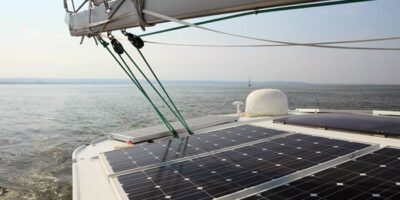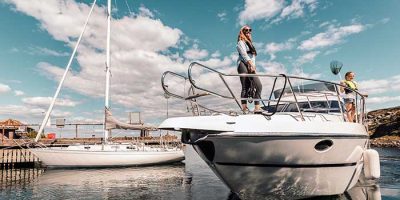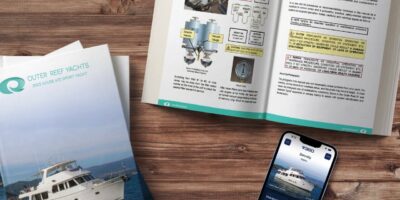Antisiphon Valves
Prevent down-flooding with antisiphon valves. Learn the causes and importance of proper installation for marine systems.
- January 29, 2024
As a small boy, I clearly recall the first time I witnessed a siphon in action. A neighbor needed to pump out a boat that was stored on land. He placed a garden hose inside the boat, filled the hose with water, then held his thumb over the discharge end and brought it up over the side of the boat and down to the ground. When he removed his thumb, the water in the hose drained, beginning the siphon, which continued until the boat was empty.
How siphons can “pull” water upward remains a mystery to many boat owners and marine industry professionals alike. To explain them to apprentice technicians, one analogy I’ve used is to think of a chain being “pulled” up and out of a chain locker by a free-falling anchor. The weight of the chain going overboard exerts the force required to lift the chain from the locker.
Siphon Versus Flooding
This lack of understanding was illustrated several years ago when I was managing a boatyard that offered warranty service for a new boat dealership. I was called to repair a generator flooded with seawater. The manufacturer, one of the largest production builders in the country, told me that other owners of the same model had reported the problem. As a result, the manufacturer had issued a service bulletin, directing dealers to replace the antisiphon valve with an “improved” model. The diagnosis was that water was being forced into the generator through the raw-water intake. This made little sense to me. When water is under pressure of any sort, flooding may occur; however, these are decidedly not the conditions under which siphons occur.
Skeptical of the prognosis, I directed the mechanic installing the replacement generator to take two additional steps: leave the exhaust hose separated from the exhaust elbow (so I could see water entering the exhaust without it filling the engine’s cylinders); and separate the raw-water-inlet hose from the raw-water pump (so I could see water being forced through this location).
During a sea trial no water gushed from the raw-water intake as the manufacturer suggested. It did, however, enter the exhaust system from the exhaust outlet on the side of the hull. At just the right speed, the bow wave moved aft and entered this exhaust flange, forcing water into and ultimately filling the exhaust and then the generator. This problem was solved by adding a simple deflector forward of the exhaust outlet. That was the easy part. It took me weeks to convince the manufacturer that the culprit was not the antisiphon valve; it was, instead, the design of the vessel and the location of the exhaust outlet.
Siphon Causes
Siphons can lead to serious problems, including down-flooding and even sinking. Raw-water siphons are most common in engines and generators, heads, and bilges. For engines and generators, siphons are a danger when they are installed below the waterline and can occur when water drawn into the engine for cooling continues to flow after the engine is shut down (like filling the aforementioned garden hose and then lowering it to the ground). If this happens, seawater will first flow into the exhaust the same way it does while the boat’s running; however, and depending on the exhaust system design, without exhaust gases to expel the water, it will eventually fill the muffler, the hoses, and then the engine itself. Under the right circumstances, water may then leak out of the engine’s air intake and into the boat, causing it to flood and possibly sink. I’ve seen this transpire over the course of just a day or two.
Heads and bilge pumps can suffer the same fate. If the overboard discharge is lower than the inlet, and most are, then seawater may continue to flow after a head has been flushed. The insidious aspect of this problem is that it may not happen for years. A siphon is often not possible if the rubber flapper valves in the head are in good condition—also true for an engine’s impeller or (diaphragm) bilge pump—or simply if the right, or wrong, conditions of wind, waves, angle of heel, etc. don’t manifest themselves.
For bilge pumps, the problem is exceedingly simple. Siphons begin when the overboard discharge is submerged, in spite of the fact that the hose rises at some point above the heeled waterline. (If it doesn’t rise above the waterline, then it’s simple down-flooding rather than siphoning, and an antisiphon valve would not prevent it.) The water running back into the bilge initiates the self-sustaining siphon.
Antisiphon Valves
In simple terms, antisiphon valves allow air to enter while preventing water under pressure from exiting the plumbing run, thereby “breaking” the siphon. Every engine, generator, head, and bilge pump needs a properly installed antisiphon valve (also called a siphon break) if they are ever below the waterline under any vessel attitude. Also note that they are not interchangeable with raw-water check valves, which are prone to failure and should be avoided in most cases (read more in “The Many Weaknesses of Raw-Water Check Valves”).
Antisiphon valves are typically installed: between the heat exchanger and the injection point on the exhaust elbow; between the raw-water flush pump and the toilet bowl (they are commonly and incorrectly installed on the pump inlet, where they will suck air); and anywhere along the discharge line for the bilge pump.
Most important is that the antisiphon valve be installed well above the waterline under all operating conditions. Some antisiphon valve manufacturers require the valve to be installed a minimum of 2’ (61cm) above the waterline to ensure proper operation, so make certain you read the installation instructions regardless of how many times you’ve installed these valves. Antisiphon valves should be inspected regularly, and serviced, disassembled, and cleaned annually to prevent clogging. If you are uncertain that an antisiphon valve is necessary, then install one. There’s little harm in having one where it’s not needed; however, untold difficulty and damage may occur when one is needed but was never installed.
Steve D’Antonio
Steve D’Antonio Marine Consulting
About Vessel Vanguard
Vessel Vanguard is a leading marine safety and maintenance management software provider dedicated to revolutionizing the maritime industry. With a commitment to innovation and excellence, Vessel Vanguard delivers cutting-edge solutions to streamline operations and enhance vessel performance and safety.
Latest Industry Insights

Embracing E-Boating Efficiencies

Boat Fuel Systems

The Future of Boats & Boating

Yacht Navigation Light Inspection
View All of Our Industry Insights
Navigate maritime with the latest news, practical how-to guides, insightful analyses and more.
